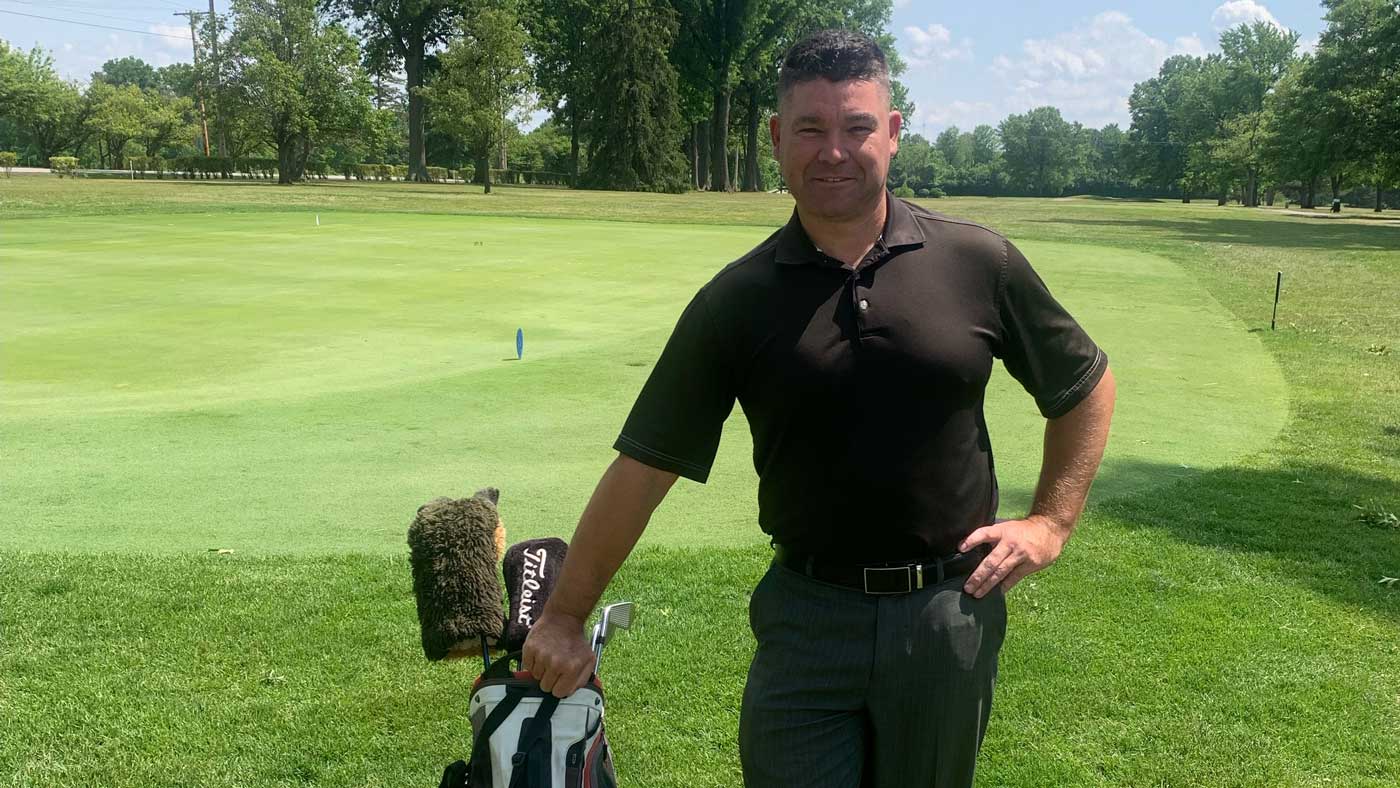
Ben Hogan qualified for the 2023 U.S. Mid-Amateur, which begins Saturday.
courtesy
When Ben Hogan was growing up in northeast Ohio, he played most of his golf at Oberlin Golf Club, a leafy hangout with roots in the 19th century. When Ben’s parents picked him up at the end of the day, they would sometimes call the pro shop to see if he was ready to come home. If the club attendant was unfamiliar with the family, the reply often went something like this:
You’re looking for Ben…HOGAN? Ohhhkay.
Click.
“They would think it’s a prank,” Hogan, now 42, said in a phone interview earlier this week.
Let the record show that your correspondent was not speaking with the Ben Hogan, the legendarily intense grinder and nine-time major winner who died in 1997 at the age of 84. No, the Hogan on the other end of the line was a retired police officer who has played golf — more proficiently than most — for nearly all of his life and last month qualified for his first United States Golf Association event, the U.S. Mid-Amateur, which kicks off Saturday at the dual host sites of Sleepy Hollow Country Club and Fenway Golf Club, just north of New York City.
When you scan the field for the Mid-Am — which always brings together an intriguing mix of players who this year includes Sam Straka, whose brother Sepp is playing for Europe in the Ryder Cup later this month; Travis Wadkins, son of Lanny; and Andrew Paysee, Scottie Scheffler’s brother-in-law — it’s impossible for Hogan’s name not to pique your curiosity, just as, say, a Yankees minor-leaguer named Babe Ruth might raise an eyebrow.
Hogan gets it. Ever since he’s been old enough to answer questions about his name, he’s been doing just that. The first query is usually, How’d you get it? It was passed down to him. Well, sort of. When Ben’s father Patrick was growing up in the 1960s and early 70s, his golf pals jokingly called him “Ben.” The moniker grew on Patrick — so much so that he christened his son with the name.
Ben said he was 12 or 13 when the significance of his name first started to register with him. Sometimes he’d have trouble booking tee times under Ben Hogan, so he used his friends’ names instead. Other times — as he ascended the local junior ranks — he felt pangs of pressure. “People just assumed that I had to be really good at golf because of my name,” he said. “I was always having to validate my golf.”
And validate it he did. During his senior year at Midview High School, Ben finished third in the state championship. When he graduated in 1999, he was good enough to play college golf but felt campus life wasn’t for him, so he took a job at his childhood club. Soon after, he moved to the San Diego area, where his father had transferred for work, and that’s where Ben decided to make a run at a professional playing career.
As Ben bounced around the mini tours, questions about his name didn’t cease, nor did the sense that he needed to live up to his name.
“I always felt like I had to prove myself, just because I get a lot of media attention,” he said. “I’ve had plenty of reporters talk to me for 10 or 15 minutes and pretty much forget to ask me about golf or how I played that day.”

courtesy
Is it possible, though, I asked Hogan, that the name also has been a valuable motivator? Asked another way, if he had been named, say, John or Michael, might he not have become the player he is?
“I don’t think so,” Hogan said. “I’ve been in love with this game as long as I could remember. If I would have been named whatever, I have a feeling I would still have a great passion for this game.”
That passion, though, took Hogan only so far in his professional career. By 2005, it was crunch time. He set himself performance goals for the season — greens in reg, putts per green, etc. Hit them and he’d keep playing. Miss them and he’d pull the plug. He missed them. But there still was reason for optimism, because Hogan had a Plan B.
“What I really wanted to do my whole life,” he said, “was be a police officer.”
Hogan played his last professional tournament in September 2005. By December, he said, he was on the force with the San Diego Police Department. His dream job. The work consumed him. So much so that he barely had time for golf, save for the occasional work outing. (“I was very popular when it came to police and firemen scrambles,” he joked.)
Policing was rewarding but also dangerous. In 2011, Hogan was injured on the scene at a domestic dispute, but not as badly as his partner, who was shot in the head. The officer survived, but the incident shook Hogan, as did other on-the-job scares. Doctors diagnosed Hogan with post-traumatic stress disorder and recommended he take medical leave. “I didn’t agree,” he said. “I wanted to go out on my own terms.” Still, he acquiesced.
With more time on his hands — he retired from the force in 2019 — Hogan returned to golf. “It was my therapy, being alone on the golf course,” he said. “It took my mind off other stuff.” His form returned, and, as a reinstated amateur, he began playing in and trying to qualify for high-level amateur competitions.
Before breaking through this year in his Mid-Amateur qualifier, Hogan said he had tried to qualify for “four or five” U.S. Opens (once advancing to sectional qualifying), two U.S. Amateurs and three other U.S. Mid-Ams. At a 2018 Mid-Am qualifier in Ohio, another familiar name was in the field — Nicklaus, as in Gary Nicklaus, Jack’s son. Tournament organizers whimsically grouped Hogan and Nicklaus together. (For what it’s worth, Hogan said he has never had any contact with anyone connected to the Ben Hogan’s family.)
At this year’s Mid-Am qualifier in Ohio, Hogan was cruising. Then he double-bogeyed the 16th hole and bogeyed the 17th. Suddenly he needed a nine-footer for par at the last to get into a 5-for-1 playoff. He holed it, then holed a much longer shot — from 150 yards — on the first playoff hole to secure the last qualifying spot. “More dramatic than I wanted,” he said of the finish.
But he was in. At 8:17 a.m. Saturday, Hogan will tee off at Sleepy Hollow in his first-ever USGA championship; if he makes the 36-hole stroke-play cut, match play begins Monday. The challenging host courses will ask him questions, and surely so too will the media — about his name.
“I’m kind of ready for them,” Hogan said. “I’m not annoyed by it. I’m 42 now. It’s nothing new. And if I can get my story out there and help people with mental health — if I can help somebody, then that’s good enough for me.”
Here, Hogan began to choke up.
“It’s not the end of the world,” he said of confronting mental-health challenges. “It’s always going to be there, I know that. But it is something that’s completely manageable. You can still have a good life. Whatever you have in your life that brings you that peace or that calm — when you haven’t felt joy in a while, whatever you have that can do that, find it and take advantage of it. For me, that is golf.”
Hogan’s reclusive namesake was not one to discuss his mental health in public, nor just about anything else for that matter. For most of the OG Hogan’s career, even the mechanics of his fabled swing remained a mystery, spawning much speculation about his “secret.” Later in his life, Hogan dropped clues about what made his swing tick — his keys ranged from cupping his left wrist in his backswing to merely “digging it out of the dirt” — without ever fully disclosing his so-called secret in definitive terms.
But how about Ohio’s Ben Hogan? Might he be willing to part with the secret to his own golfing success?
“Whatever secret I have, it usually changes week to week,” he said, laughing. “My secret would be whatever’s working for you at the time, don’t fight it, embrace it. That’s my secret: Just play the best golf that you can on that day.”











